BHP Billion: ERP Implementation, Market Analysis, and Recommendations
VerifiedAdded on 2024/05/23
|14
|3340
|394
Report
AI Summary
This report provides an in-depth analysis of BHP Billion's organizational structure, highlighting operational problems stemming from its matrix structure. It proposes the implementation of an ERP system to address these issues, detailing the system's benefits, a sales procedure flowchart, and potential control problems. The report also examines the development and adoption of accounting software in Australia, focusing on market size, key players, current gaps, and challenges. Recommendations are made to enhance the company's IT alignment and decision-making processes. The analysis covers the evolution of accounting software, the increasing demand for cloud-based solutions, and the factors influencing software selection, providing a comprehensive overview of ERP systems and their strategic implications for BHP Billion.
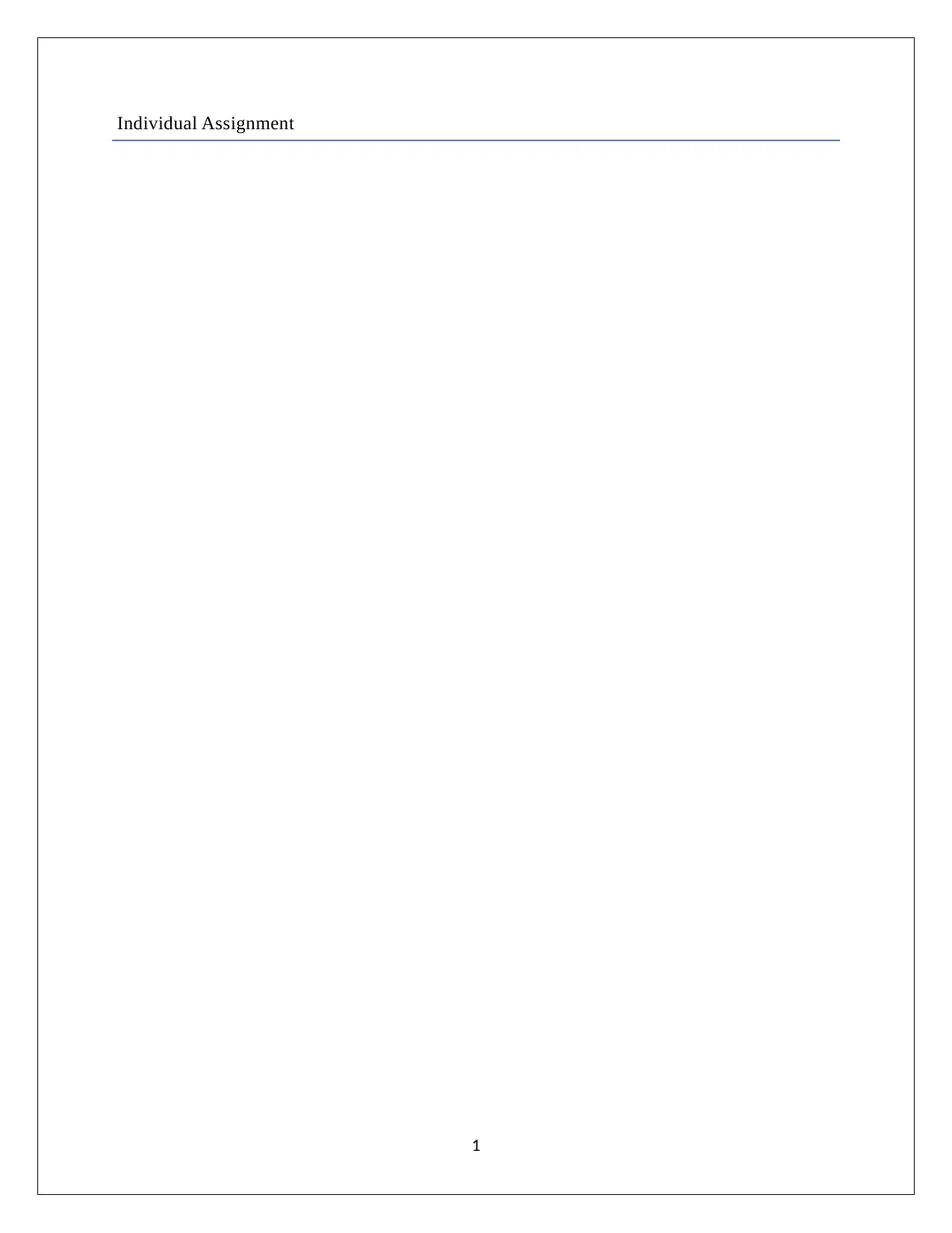
Individual Assignment
1
1
Paraphrase This Document
Need a fresh take? Get an instant paraphrase of this document with our AI Paraphraser
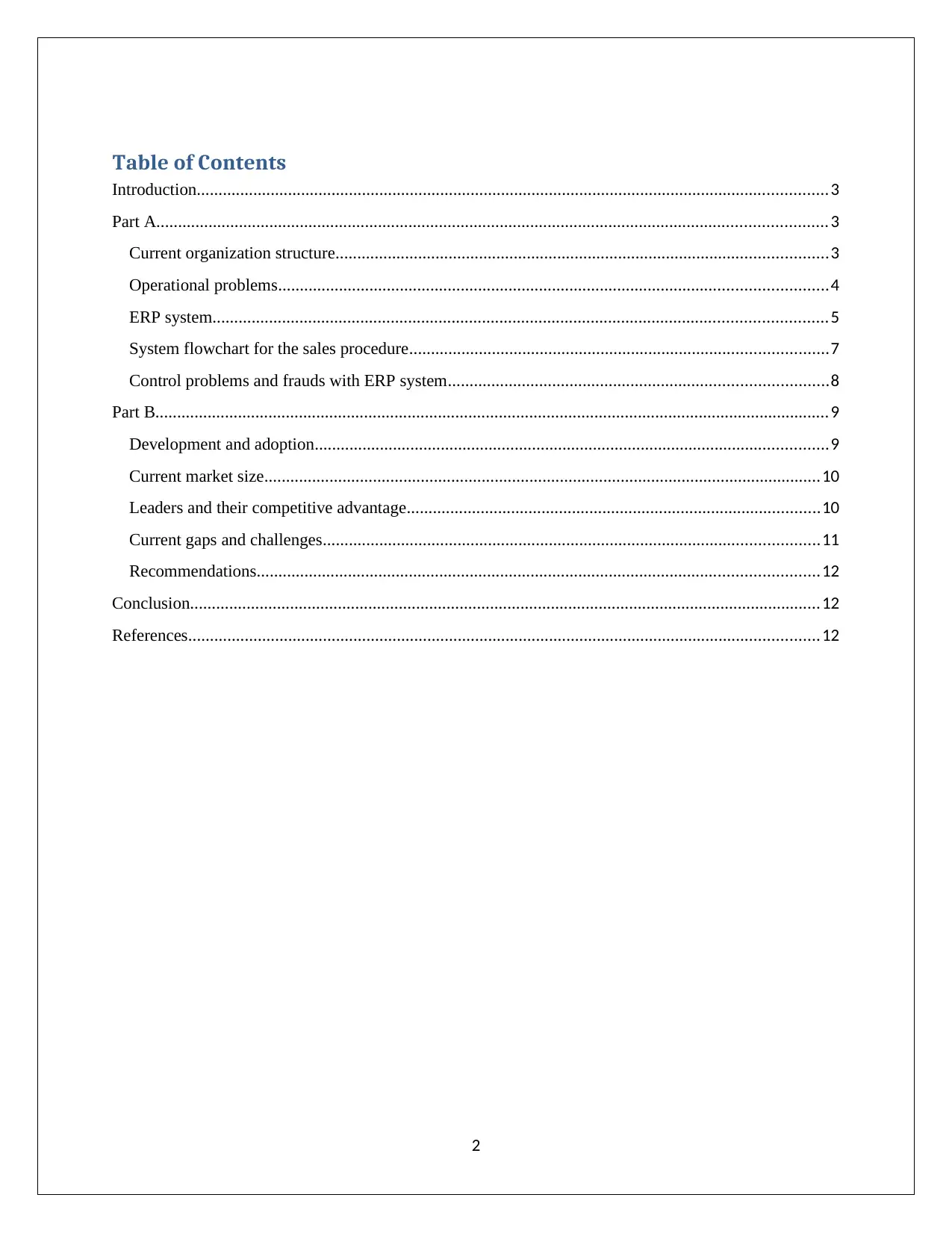
Table of Contents
Introduction.................................................................................................................................................3
Part A..........................................................................................................................................................3
Current organization structure.................................................................................................................3
Operational problems..............................................................................................................................4
ERP system.............................................................................................................................................5
System flowchart for the sales procedure................................................................................................7
Control problems and frauds with ERP system.......................................................................................8
Part B...........................................................................................................................................................9
Development and adoption......................................................................................................................9
Current market size................................................................................................................................10
Leaders and their competitive advantage...............................................................................................10
Current gaps and challenges..................................................................................................................11
Recommendations.................................................................................................................................12
Conclusion.................................................................................................................................................12
References.................................................................................................................................................12
2
Introduction.................................................................................................................................................3
Part A..........................................................................................................................................................3
Current organization structure.................................................................................................................3
Operational problems..............................................................................................................................4
ERP system.............................................................................................................................................5
System flowchart for the sales procedure................................................................................................7
Control problems and frauds with ERP system.......................................................................................8
Part B...........................................................................................................................................................9
Development and adoption......................................................................................................................9
Current market size................................................................................................................................10
Leaders and their competitive advantage...............................................................................................10
Current gaps and challenges..................................................................................................................11
Recommendations.................................................................................................................................12
Conclusion.................................................................................................................................................12
References.................................................................................................................................................12
2
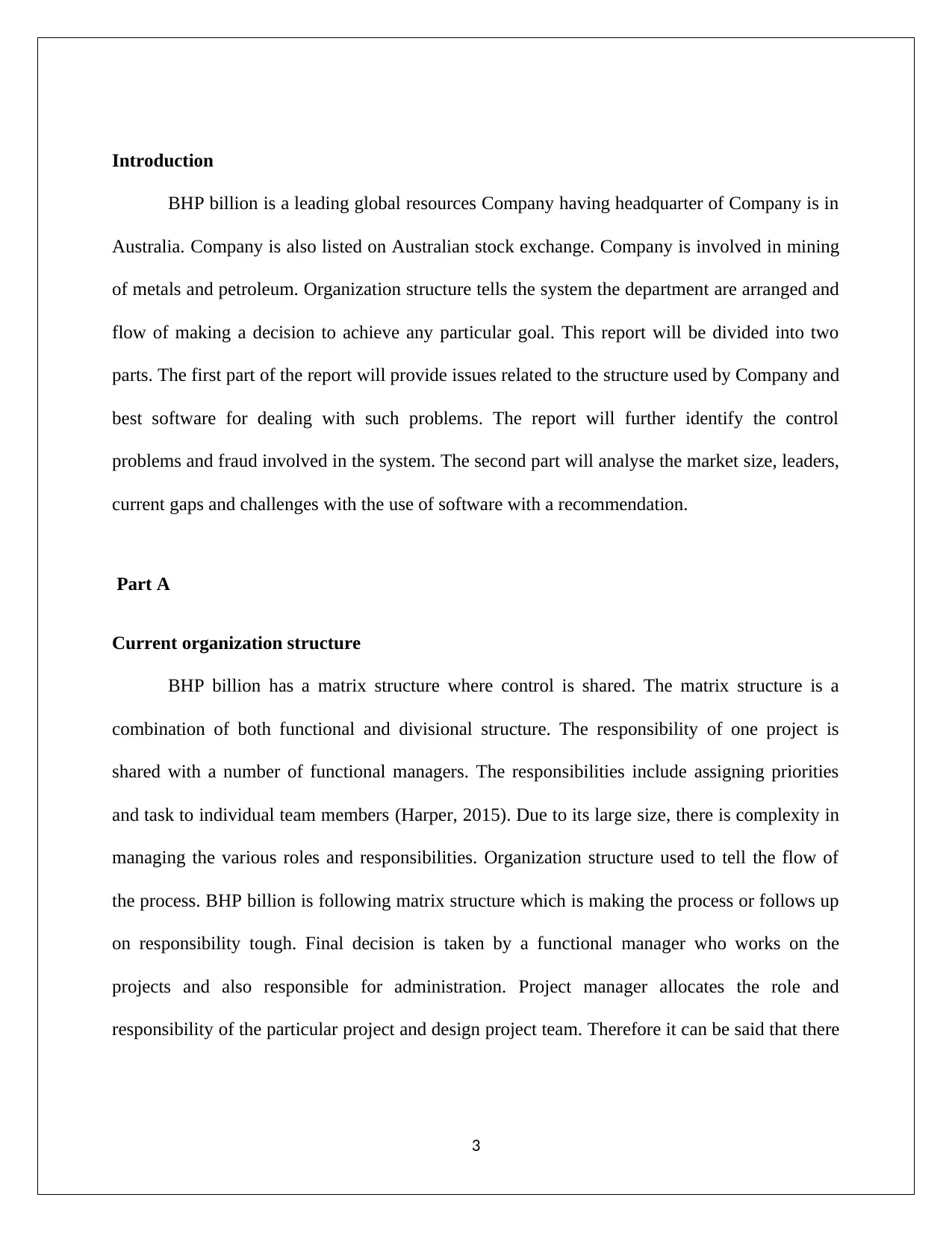
Introduction
BHP billion is a leading global resources Company having headquarter of Company is in
Australia. Company is also listed on Australian stock exchange. Company is involved in mining
of metals and petroleum. Organization structure tells the system the department are arranged and
flow of making a decision to achieve any particular goal. This report will be divided into two
parts. The first part of the report will provide issues related to the structure used by Company and
best software for dealing with such problems. The report will further identify the control
problems and fraud involved in the system. The second part will analyse the market size, leaders,
current gaps and challenges with the use of software with a recommendation.
Part A
Current organization structure
BHP billion has a matrix structure where control is shared. The matrix structure is a
combination of both functional and divisional structure. The responsibility of one project is
shared with a number of functional managers. The responsibilities include assigning priorities
and task to individual team members (Harper, 2015). Due to its large size, there is complexity in
managing the various roles and responsibilities. Organization structure used to tell the flow of
the process. BHP billion is following matrix structure which is making the process or follows up
on responsibility tough. Final decision is taken by a functional manager who works on the
projects and also responsible for administration. Project manager allocates the role and
responsibility of the particular project and design project team. Therefore it can be said that there
3
BHP billion is a leading global resources Company having headquarter of Company is in
Australia. Company is also listed on Australian stock exchange. Company is involved in mining
of metals and petroleum. Organization structure tells the system the department are arranged and
flow of making a decision to achieve any particular goal. This report will be divided into two
parts. The first part of the report will provide issues related to the structure used by Company and
best software for dealing with such problems. The report will further identify the control
problems and fraud involved in the system. The second part will analyse the market size, leaders,
current gaps and challenges with the use of software with a recommendation.
Part A
Current organization structure
BHP billion has a matrix structure where control is shared. The matrix structure is a
combination of both functional and divisional structure. The responsibility of one project is
shared with a number of functional managers. The responsibilities include assigning priorities
and task to individual team members (Harper, 2015). Due to its large size, there is complexity in
managing the various roles and responsibilities. Organization structure used to tell the flow of
the process. BHP billion is following matrix structure which is making the process or follows up
on responsibility tough. Final decision is taken by a functional manager who works on the
projects and also responsible for administration. Project manager allocates the role and
responsibility of the particular project and design project team. Therefore it can be said that there
3
⊘ This is a preview!⊘
Do you want full access?
Subscribe today to unlock all pages.

Trusted by 1+ million students worldwide
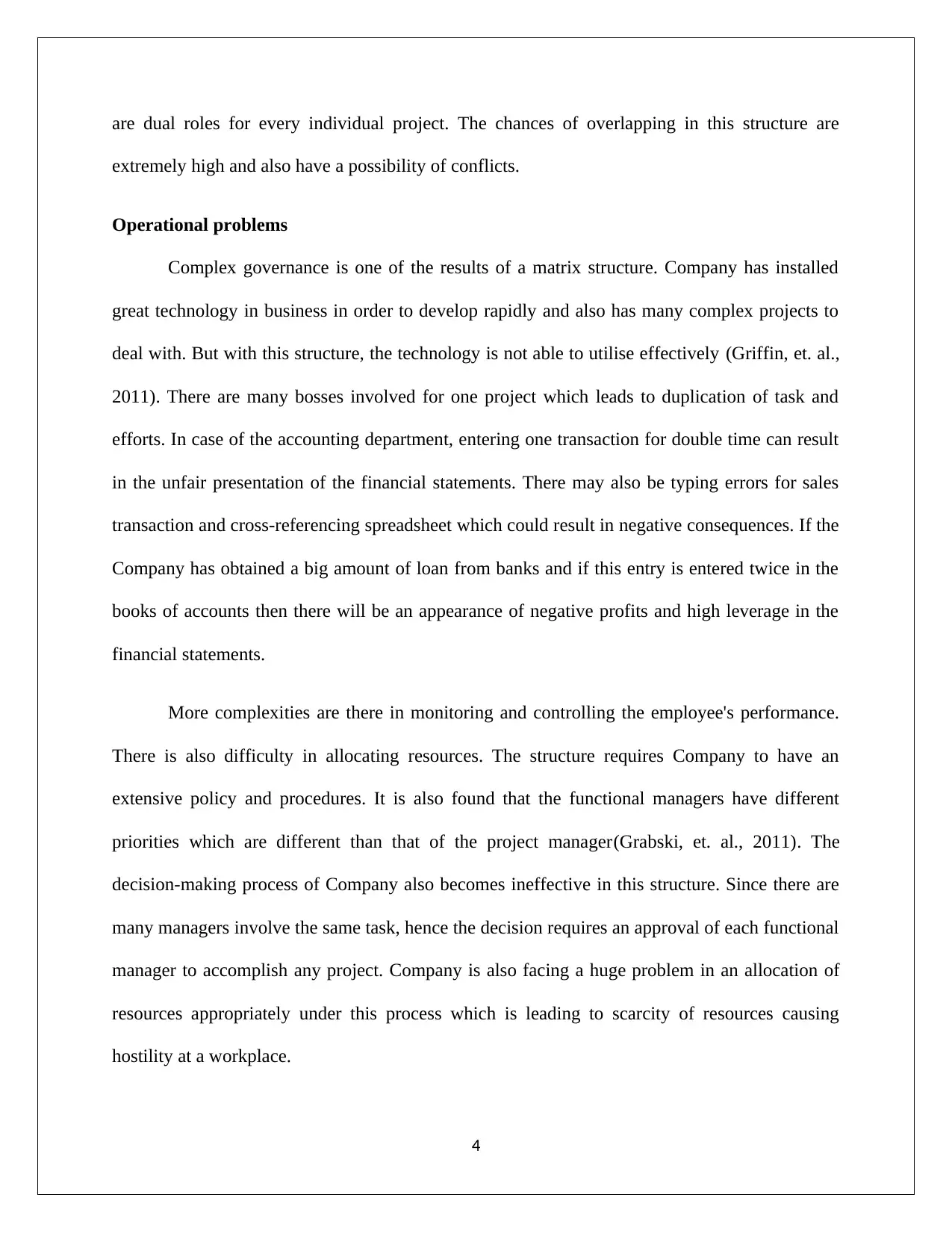
are dual roles for every individual project. The chances of overlapping in this structure are
extremely high and also have a possibility of conflicts.
Operational problems
Complex governance is one of the results of a matrix structure. Company has installed
great technology in business in order to develop rapidly and also has many complex projects to
deal with. But with this structure, the technology is not able to utilise effectively (Griffin, et. al.,
2011). There are many bosses involved for one project which leads to duplication of task and
efforts. In case of the accounting department, entering one transaction for double time can result
in the unfair presentation of the financial statements. There may also be typing errors for sales
transaction and cross-referencing spreadsheet which could result in negative consequences. If the
Company has obtained a big amount of loan from banks and if this entry is entered twice in the
books of accounts then there will be an appearance of negative profits and high leverage in the
financial statements.
More complexities are there in monitoring and controlling the employee's performance.
There is also difficulty in allocating resources. The structure requires Company to have an
extensive policy and procedures. It is also found that the functional managers have different
priorities which are different than that of the project manager(Grabski, et. al., 2011). The
decision-making process of Company also becomes ineffective in this structure. Since there are
many managers involve the same task, hence the decision requires an approval of each functional
manager to accomplish any project. Company is also facing a huge problem in an allocation of
resources appropriately under this process which is leading to scarcity of resources causing
hostility at a workplace.
4
extremely high and also have a possibility of conflicts.
Operational problems
Complex governance is one of the results of a matrix structure. Company has installed
great technology in business in order to develop rapidly and also has many complex projects to
deal with. But with this structure, the technology is not able to utilise effectively (Griffin, et. al.,
2011). There are many bosses involved for one project which leads to duplication of task and
efforts. In case of the accounting department, entering one transaction for double time can result
in the unfair presentation of the financial statements. There may also be typing errors for sales
transaction and cross-referencing spreadsheet which could result in negative consequences. If the
Company has obtained a big amount of loan from banks and if this entry is entered twice in the
books of accounts then there will be an appearance of negative profits and high leverage in the
financial statements.
More complexities are there in monitoring and controlling the employee's performance.
There is also difficulty in allocating resources. The structure requires Company to have an
extensive policy and procedures. It is also found that the functional managers have different
priorities which are different than that of the project manager(Grabski, et. al., 2011). The
decision-making process of Company also becomes ineffective in this structure. Since there are
many managers involve the same task, hence the decision requires an approval of each functional
manager to accomplish any project. Company is also facing a huge problem in an allocation of
resources appropriately under this process which is leading to scarcity of resources causing
hostility at a workplace.
4
Paraphrase This Document
Need a fresh take? Get an instant paraphrase of this document with our AI Paraphraser

BHP billion is also facing problem in IT alignment into the business strategy.
Miscommunication is one of the disadvantages of the structure where employees may get
confused as who is their superior and may result in dissatisfaction and ineffective management.
The overhead cost is also high with multiple managers. Coordination is another problem with
this structure and which results in achieving the goals in long duration. Coordination problem
mainly occurs when the information is to be gathered from multiple levels. There are a number
of meetings held for taking any critical decision and thus more time is invested in arranging
meetings and making its successful resulting in wastage of efforts and time. BHP billion has
business in multiple locations and arranging meeting becomes a long process and further, the
decision making also becomes a hard task to be achieved (Grabski, et. al., 2011). This could be
utilised in further effective activities ensuring a smooth functioning of a business. It is also
difficult to identify the person accountable for any failure of the project due to an involvement of
various parties in the same project.
ERP system
ERP software is comprehensive software which allows management of many activities
on one platform. The most likely system for such structural issue is ERP system. There is high
visibility in using ERP software (Azevedo, et. al., 2012). The accessibility is very high as any
entry of data is software can be viewed by any department easily. Thus there will be no long
process required for asking the manager on making a decision based on the data. A manager can
also monitor the level of inventory on daily basis. A better control will be achieved for working
capital with a better adheres to the strategy developed in ensuring long-term success for a
business. The information of BHP billion will be able at a centralised location and therefore the
problem of coordination will be removed bringing streamline in the completion of a task. There
5
Miscommunication is one of the disadvantages of the structure where employees may get
confused as who is their superior and may result in dissatisfaction and ineffective management.
The overhead cost is also high with multiple managers. Coordination is another problem with
this structure and which results in achieving the goals in long duration. Coordination problem
mainly occurs when the information is to be gathered from multiple levels. There are a number
of meetings held for taking any critical decision and thus more time is invested in arranging
meetings and making its successful resulting in wastage of efforts and time. BHP billion has
business in multiple locations and arranging meeting becomes a long process and further, the
decision making also becomes a hard task to be achieved (Grabski, et. al., 2011). This could be
utilised in further effective activities ensuring a smooth functioning of a business. It is also
difficult to identify the person accountable for any failure of the project due to an involvement of
various parties in the same project.
ERP system
ERP software is comprehensive software which allows management of many activities
on one platform. The most likely system for such structural issue is ERP system. There is high
visibility in using ERP software (Azevedo, et. al., 2012). The accessibility is very high as any
entry of data is software can be viewed by any department easily. Thus there will be no long
process required for asking the manager on making a decision based on the data. A manager can
also monitor the level of inventory on daily basis. A better control will be achieved for working
capital with a better adheres to the strategy developed in ensuring long-term success for a
business. The information of BHP billion will be able at a centralised location and therefore the
problem of coordination will be removed bringing streamline in the completion of a task. There
5
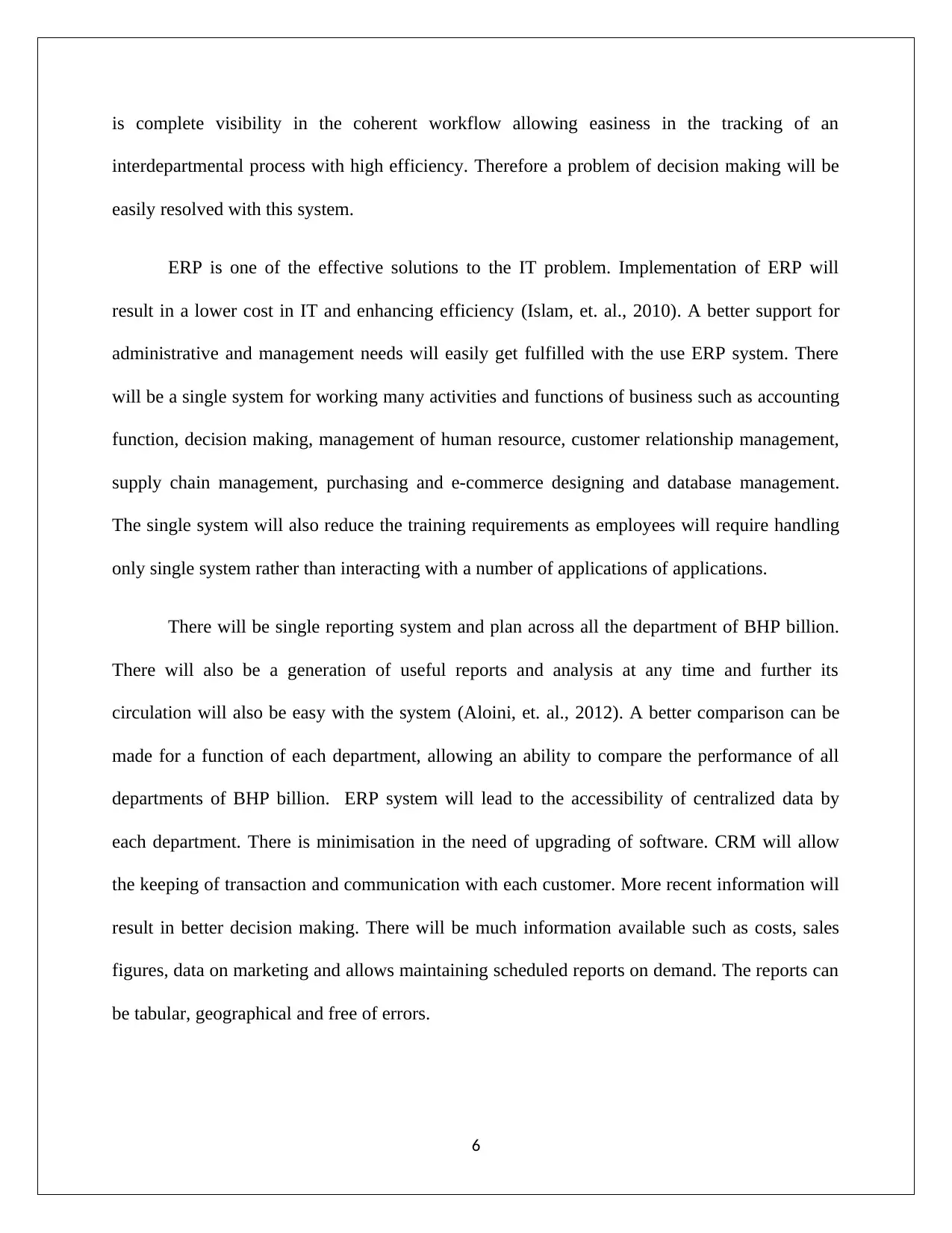
is complete visibility in the coherent workflow allowing easiness in the tracking of an
interdepartmental process with high efficiency. Therefore a problem of decision making will be
easily resolved with this system.
ERP is one of the effective solutions to the IT problem. Implementation of ERP will
result in a lower cost in IT and enhancing efficiency (Islam, et. al., 2010). A better support for
administrative and management needs will easily get fulfilled with the use ERP system. There
will be a single system for working many activities and functions of business such as accounting
function, decision making, management of human resource, customer relationship management,
supply chain management, purchasing and e-commerce designing and database management.
The single system will also reduce the training requirements as employees will require handling
only single system rather than interacting with a number of applications of applications.
There will be single reporting system and plan across all the department of BHP billion.
There will also be a generation of useful reports and analysis at any time and further its
circulation will also be easy with the system (Aloini, et. al., 2012). A better comparison can be
made for a function of each department, allowing an ability to compare the performance of all
departments of BHP billion. ERP system will lead to the accessibility of centralized data by
each department. There is minimisation in the need of upgrading of software. CRM will allow
the keeping of transaction and communication with each customer. More recent information will
result in better decision making. There will be much information available such as costs, sales
figures, data on marketing and allows maintaining scheduled reports on demand. The reports can
be tabular, geographical and free of errors.
6
interdepartmental process with high efficiency. Therefore a problem of decision making will be
easily resolved with this system.
ERP is one of the effective solutions to the IT problem. Implementation of ERP will
result in a lower cost in IT and enhancing efficiency (Islam, et. al., 2010). A better support for
administrative and management needs will easily get fulfilled with the use ERP system. There
will be a single system for working many activities and functions of business such as accounting
function, decision making, management of human resource, customer relationship management,
supply chain management, purchasing and e-commerce designing and database management.
The single system will also reduce the training requirements as employees will require handling
only single system rather than interacting with a number of applications of applications.
There will be single reporting system and plan across all the department of BHP billion.
There will also be a generation of useful reports and analysis at any time and further its
circulation will also be easy with the system (Aloini, et. al., 2012). A better comparison can be
made for a function of each department, allowing an ability to compare the performance of all
departments of BHP billion. ERP system will lead to the accessibility of centralized data by
each department. There is minimisation in the need of upgrading of software. CRM will allow
the keeping of transaction and communication with each customer. More recent information will
result in better decision making. There will be much information available such as costs, sales
figures, data on marketing and allows maintaining scheduled reports on demand. The reports can
be tabular, geographical and free of errors.
6
⊘ This is a preview!⊘
Do you want full access?
Subscribe today to unlock all pages.

Trusted by 1+ million students worldwide
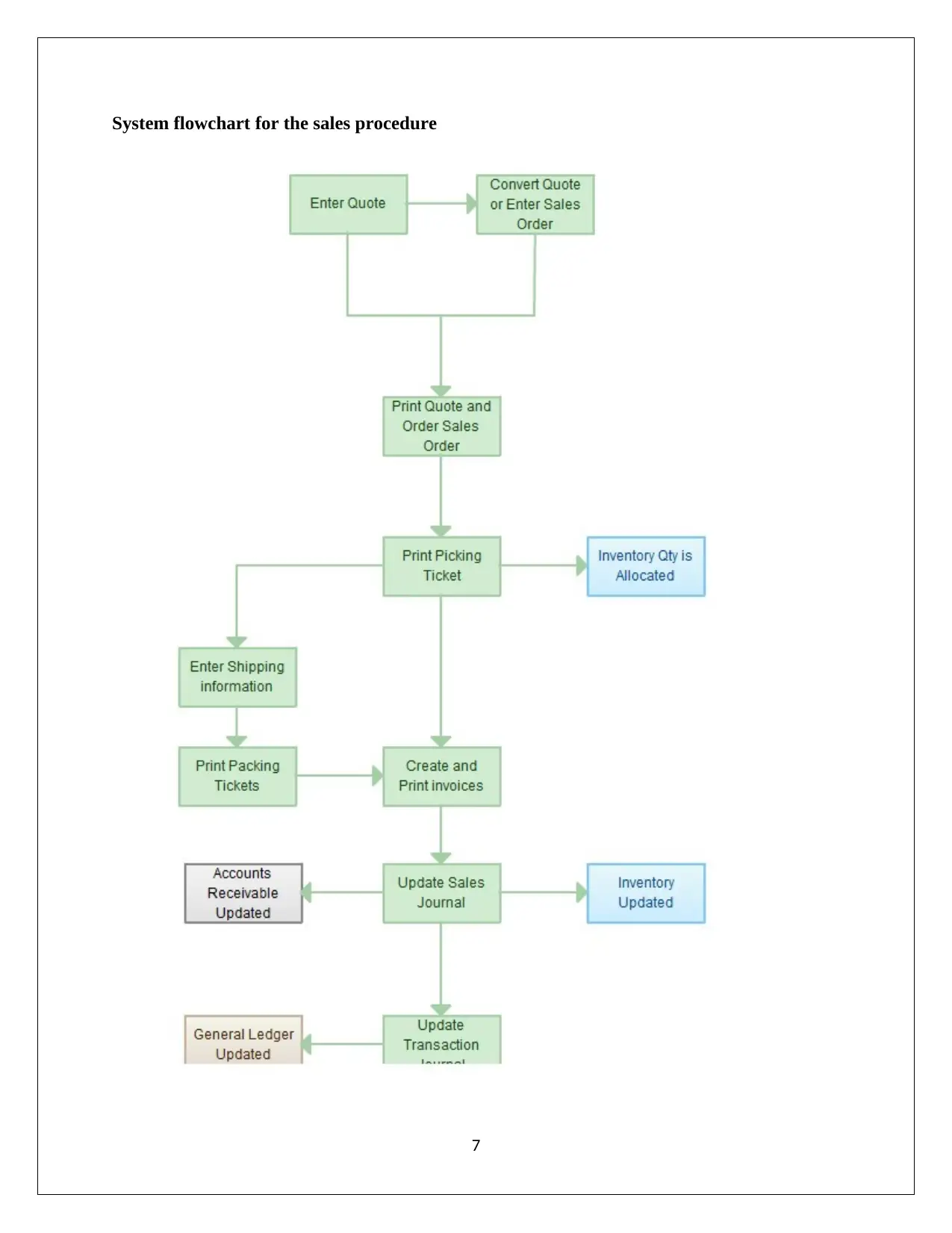
System flowchart for the sales procedure
7
7
Paraphrase This Document
Need a fresh take? Get an instant paraphrase of this document with our AI Paraphraser
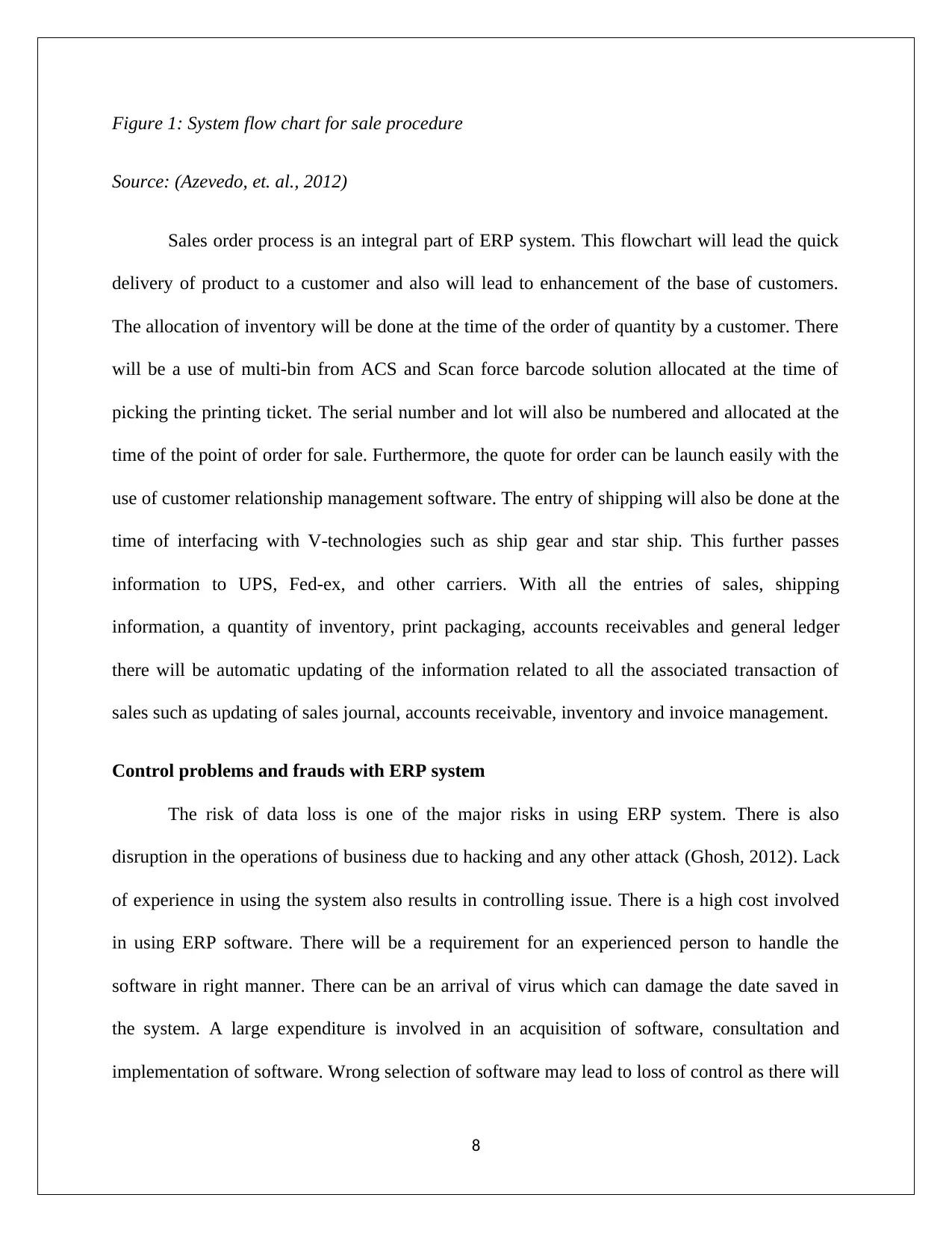
Figure 1: System flow chart for sale procedure
Source: (Azevedo, et. al., 2012)
Sales order process is an integral part of ERP system. This flowchart will lead the quick
delivery of product to a customer and also will lead to enhancement of the base of customers.
The allocation of inventory will be done at the time of the order of quantity by a customer. There
will be a use of multi-bin from ACS and Scan force barcode solution allocated at the time of
picking the printing ticket. The serial number and lot will also be numbered and allocated at the
time of the point of order for sale. Furthermore, the quote for order can be launch easily with the
use of customer relationship management software. The entry of shipping will also be done at the
time of interfacing with V-technologies such as ship gear and star ship. This further passes
information to UPS, Fed-ex, and other carriers. With all the entries of sales, shipping
information, a quantity of inventory, print packaging, accounts receivables and general ledger
there will be automatic updating of the information related to all the associated transaction of
sales such as updating of sales journal, accounts receivable, inventory and invoice management.
Control problems and frauds with ERP system
The risk of data loss is one of the major risks in using ERP system. There is also
disruption in the operations of business due to hacking and any other attack (Ghosh, 2012). Lack
of experience in using the system also results in controlling issue. There is a high cost involved
in using ERP software. There will be a requirement for an experienced person to handle the
software in right manner. There can be an arrival of virus which can damage the date saved in
the system. A large expenditure is involved in an acquisition of software, consultation and
implementation of software. Wrong selection of software may lead to loss of control as there will
8
Source: (Azevedo, et. al., 2012)
Sales order process is an integral part of ERP system. This flowchart will lead the quick
delivery of product to a customer and also will lead to enhancement of the base of customers.
The allocation of inventory will be done at the time of the order of quantity by a customer. There
will be a use of multi-bin from ACS and Scan force barcode solution allocated at the time of
picking the printing ticket. The serial number and lot will also be numbered and allocated at the
time of the point of order for sale. Furthermore, the quote for order can be launch easily with the
use of customer relationship management software. The entry of shipping will also be done at the
time of interfacing with V-technologies such as ship gear and star ship. This further passes
information to UPS, Fed-ex, and other carriers. With all the entries of sales, shipping
information, a quantity of inventory, print packaging, accounts receivables and general ledger
there will be automatic updating of the information related to all the associated transaction of
sales such as updating of sales journal, accounts receivable, inventory and invoice management.
Control problems and frauds with ERP system
The risk of data loss is one of the major risks in using ERP system. There is also
disruption in the operations of business due to hacking and any other attack (Ghosh, 2012). Lack
of experience in using the system also results in controlling issue. There is a high cost involved
in using ERP software. There will be a requirement for an experienced person to handle the
software in right manner. There can be an arrival of virus which can damage the date saved in
the system. A large expenditure is involved in an acquisition of software, consultation and
implementation of software. Wrong selection of software may lead to loss of control as there will
8
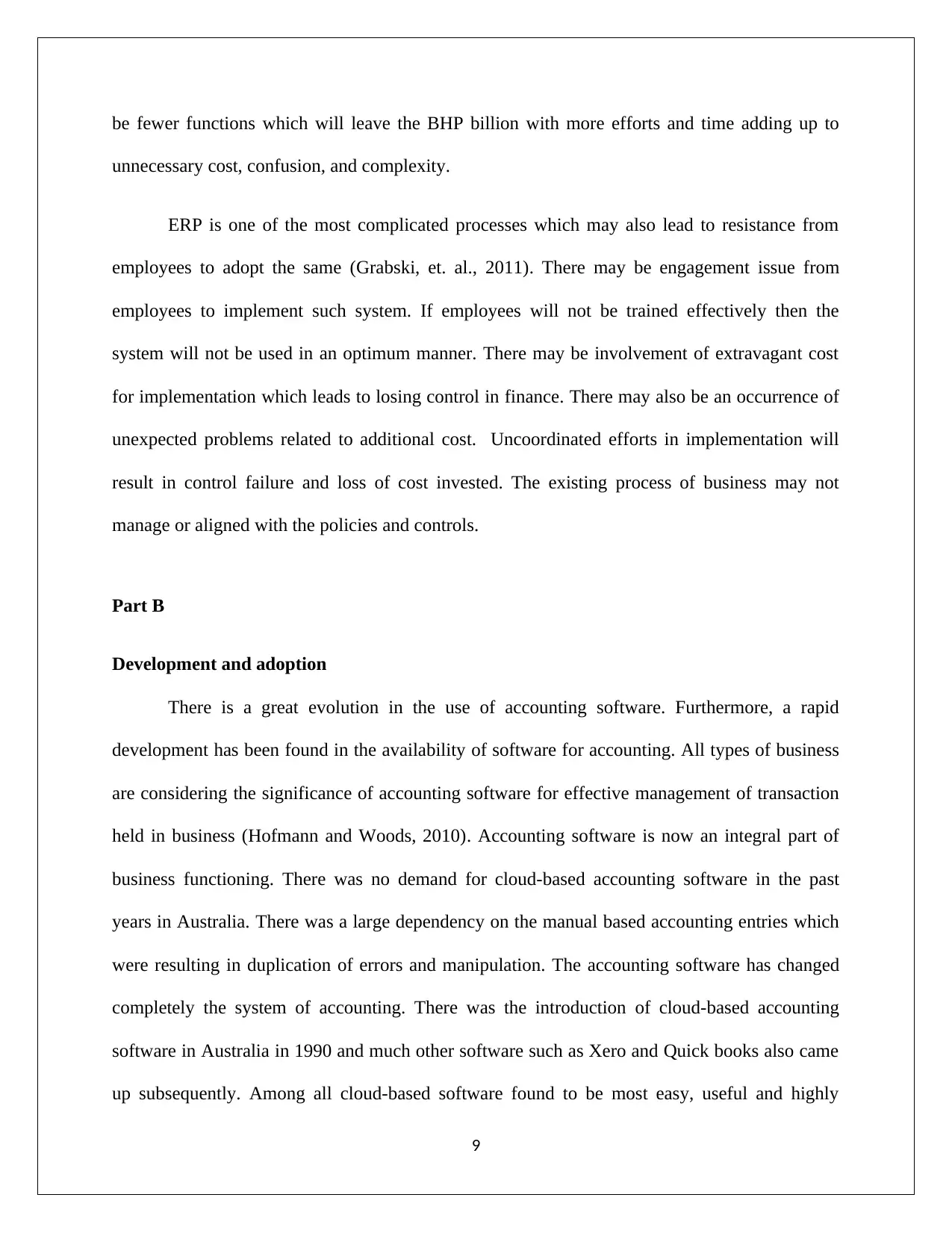
be fewer functions which will leave the BHP billion with more efforts and time adding up to
unnecessary cost, confusion, and complexity.
ERP is one of the most complicated processes which may also lead to resistance from
employees to adopt the same (Grabski, et. al., 2011). There may be engagement issue from
employees to implement such system. If employees will not be trained effectively then the
system will not be used in an optimum manner. There may be involvement of extravagant cost
for implementation which leads to losing control in finance. There may also be an occurrence of
unexpected problems related to additional cost. Uncoordinated efforts in implementation will
result in control failure and loss of cost invested. The existing process of business may not
manage or aligned with the policies and controls.
Part B
Development and adoption
There is a great evolution in the use of accounting software. Furthermore, a rapid
development has been found in the availability of software for accounting. All types of business
are considering the significance of accounting software for effective management of transaction
held in business (Hofmann and Woods, 2010). Accounting software is now an integral part of
business functioning. There was no demand for cloud-based accounting software in the past
years in Australia. There was a large dependency on the manual based accounting entries which
were resulting in duplication of errors and manipulation. The accounting software has changed
completely the system of accounting. There was the introduction of cloud-based accounting
software in Australia in 1990 and much other software such as Xero and Quick books also came
up subsequently. Among all cloud-based software found to be most easy, useful and highly
9
unnecessary cost, confusion, and complexity.
ERP is one of the most complicated processes which may also lead to resistance from
employees to adopt the same (Grabski, et. al., 2011). There may be engagement issue from
employees to implement such system. If employees will not be trained effectively then the
system will not be used in an optimum manner. There may be involvement of extravagant cost
for implementation which leads to losing control in finance. There may also be an occurrence of
unexpected problems related to additional cost. Uncoordinated efforts in implementation will
result in control failure and loss of cost invested. The existing process of business may not
manage or aligned with the policies and controls.
Part B
Development and adoption
There is a great evolution in the use of accounting software. Furthermore, a rapid
development has been found in the availability of software for accounting. All types of business
are considering the significance of accounting software for effective management of transaction
held in business (Hofmann and Woods, 2010). Accounting software is now an integral part of
business functioning. There was no demand for cloud-based accounting software in the past
years in Australia. There was a large dependency on the manual based accounting entries which
were resulting in duplication of errors and manipulation. The accounting software has changed
completely the system of accounting. There was the introduction of cloud-based accounting
software in Australia in 1990 and much other software such as Xero and Quick books also came
up subsequently. Among all cloud-based software found to be most easy, useful and highly
9
⊘ This is a preview!⊘
Do you want full access?
Subscribe today to unlock all pages.

Trusted by 1+ million students worldwide

accessible based on the internet. This has made a great contribution to the growing demand of
accounting software packages.
Current market size
In Australia, the demand for cloud-based software is gaining a wide popularity which was
less in five years back. The main problems in adoption of accounting software were the non
understanding by the traditional accountants on the manner to be adopted for use in accounting
software. Now, there are many accounting software packages available such as fresh books,
Zoho Books, MYOB and Quick books. Most of the large organization has adopted the software
but for small and medium enterprise the accounting software is quite expensive including
expenses related to hardware, backup, own server and training program. Hence, most of the
small and medium enterprise prefer cloud computing which is reasonable than any other
software (Ramazani, et. al., 2012). There are still many restrictions in adopting accounting
software such as the age of manager, number of accountants and their level of education. BHP
billion select the software based on the scale of operations, nature, and needs. The demand for
accounting software is found more from large than small and medium. The future demand for
accounting software is found from small and medium as there is growth in GDP and rise in small
and medium scale industry.
Leaders and their competitive advantage
Cloud computing can be used anywhere with having internet, there is no use of having
installed computers and hardware (Rainer, et. al., 2013). Therefore, there is high demand for
cloud computing in the market. In Australia, the most accounting software having dominance are
Xero, Quick books, Zoho and MYOB. Most common features of accounting software are fast
bank reconciliation, accessibility through a mobile application, smart reports and dashboards,
10
accounting software packages.
Current market size
In Australia, the demand for cloud-based software is gaining a wide popularity which was
less in five years back. The main problems in adoption of accounting software were the non
understanding by the traditional accountants on the manner to be adopted for use in accounting
software. Now, there are many accounting software packages available such as fresh books,
Zoho Books, MYOB and Quick books. Most of the large organization has adopted the software
but for small and medium enterprise the accounting software is quite expensive including
expenses related to hardware, backup, own server and training program. Hence, most of the
small and medium enterprise prefer cloud computing which is reasonable than any other
software (Ramazani, et. al., 2012). There are still many restrictions in adopting accounting
software such as the age of manager, number of accountants and their level of education. BHP
billion select the software based on the scale of operations, nature, and needs. The demand for
accounting software is found more from large than small and medium. The future demand for
accounting software is found from small and medium as there is growth in GDP and rise in small
and medium scale industry.
Leaders and their competitive advantage
Cloud computing can be used anywhere with having internet, there is no use of having
installed computers and hardware (Rainer, et. al., 2013). Therefore, there is high demand for
cloud computing in the market. In Australia, the most accounting software having dominance are
Xero, Quick books, Zoho and MYOB. Most common features of accounting software are fast
bank reconciliation, accessibility through a mobile application, smart reports and dashboards,
10
Paraphrase This Document
Need a fresh take? Get an instant paraphrase of this document with our AI Paraphraser
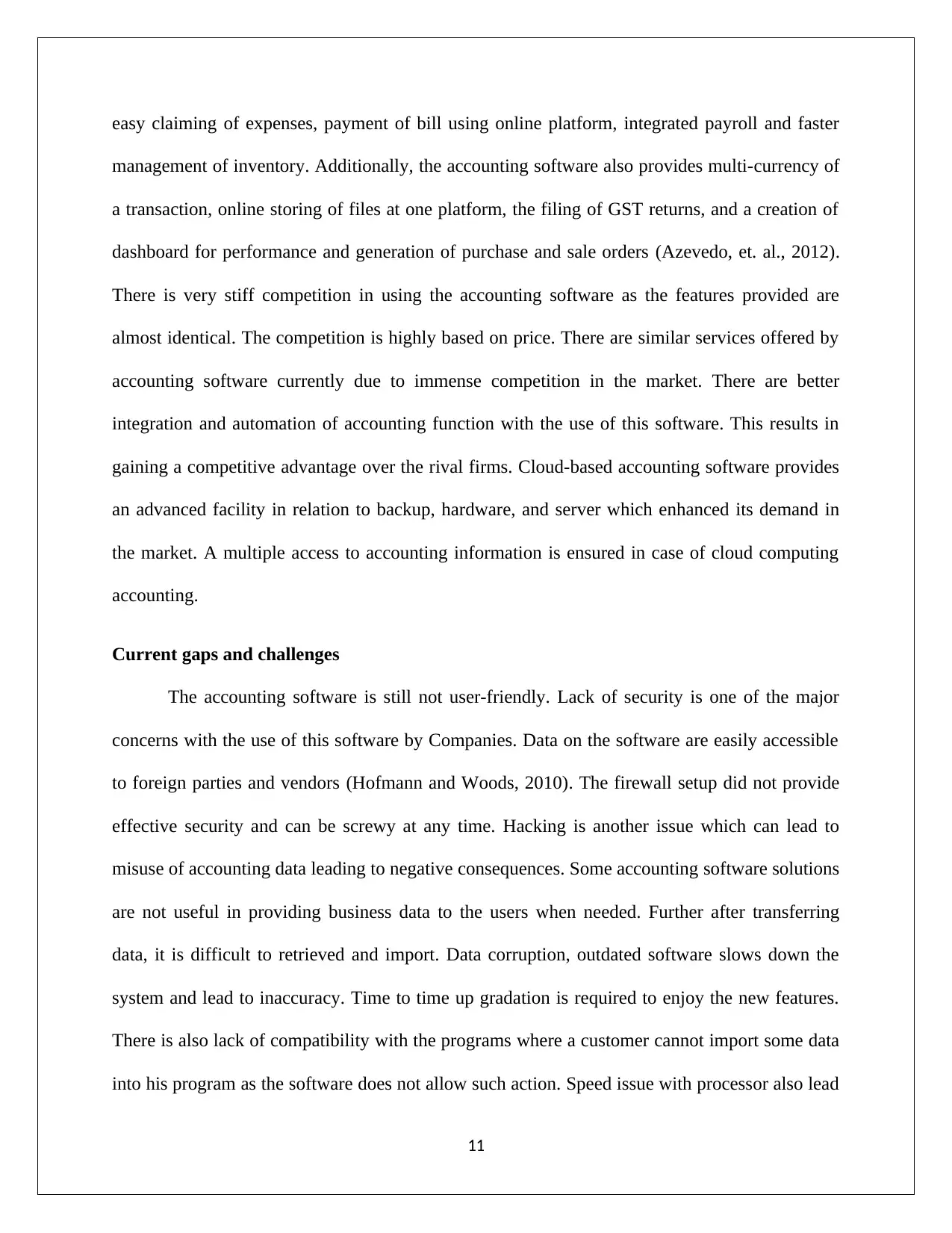
easy claiming of expenses, payment of bill using online platform, integrated payroll and faster
management of inventory. Additionally, the accounting software also provides multi-currency of
a transaction, online storing of files at one platform, the filing of GST returns, and a creation of
dashboard for performance and generation of purchase and sale orders (Azevedo, et. al., 2012).
There is very stiff competition in using the accounting software as the features provided are
almost identical. The competition is highly based on price. There are similar services offered by
accounting software currently due to immense competition in the market. There are better
integration and automation of accounting function with the use of this software. This results in
gaining a competitive advantage over the rival firms. Cloud-based accounting software provides
an advanced facility in relation to backup, hardware, and server which enhanced its demand in
the market. A multiple access to accounting information is ensured in case of cloud computing
accounting.
Current gaps and challenges
The accounting software is still not user-friendly. Lack of security is one of the major
concerns with the use of this software by Companies. Data on the software are easily accessible
to foreign parties and vendors (Hofmann and Woods, 2010). The firewall setup did not provide
effective security and can be screwy at any time. Hacking is another issue which can lead to
misuse of accounting data leading to negative consequences. Some accounting software solutions
are not useful in providing business data to the users when needed. Further after transferring
data, it is difficult to retrieved and import. Data corruption, outdated software slows down the
system and lead to inaccuracy. Time to time up gradation is required to enjoy the new features.
There is also lack of compatibility with the programs where a customer cannot import some data
into his program as the software does not allow such action. Speed issue with processor also lead
11
management of inventory. Additionally, the accounting software also provides multi-currency of
a transaction, online storing of files at one platform, the filing of GST returns, and a creation of
dashboard for performance and generation of purchase and sale orders (Azevedo, et. al., 2012).
There is very stiff competition in using the accounting software as the features provided are
almost identical. The competition is highly based on price. There are similar services offered by
accounting software currently due to immense competition in the market. There are better
integration and automation of accounting function with the use of this software. This results in
gaining a competitive advantage over the rival firms. Cloud-based accounting software provides
an advanced facility in relation to backup, hardware, and server which enhanced its demand in
the market. A multiple access to accounting information is ensured in case of cloud computing
accounting.
Current gaps and challenges
The accounting software is still not user-friendly. Lack of security is one of the major
concerns with the use of this software by Companies. Data on the software are easily accessible
to foreign parties and vendors (Hofmann and Woods, 2010). The firewall setup did not provide
effective security and can be screwy at any time. Hacking is another issue which can lead to
misuse of accounting data leading to negative consequences. Some accounting software solutions
are not useful in providing business data to the users when needed. Further after transferring
data, it is difficult to retrieved and import. Data corruption, outdated software slows down the
system and lead to inaccuracy. Time to time up gradation is required to enjoy the new features.
There is also lack of compatibility with the programs where a customer cannot import some data
into his program as the software does not allow such action. Speed issue with processor also lead
11
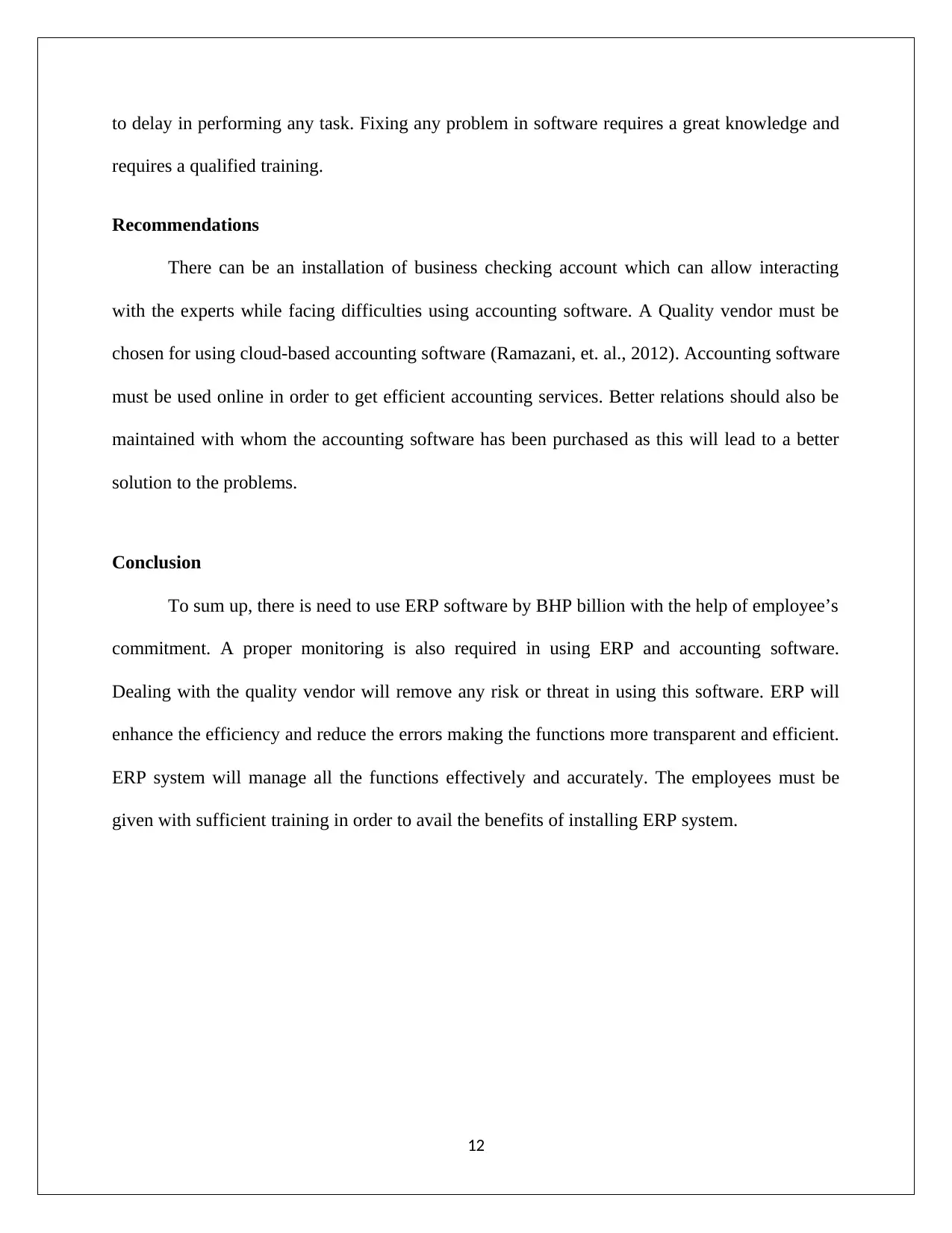
to delay in performing any task. Fixing any problem in software requires a great knowledge and
requires a qualified training.
Recommendations
There can be an installation of business checking account which can allow interacting
with the experts while facing difficulties using accounting software. A Quality vendor must be
chosen for using cloud-based accounting software (Ramazani, et. al., 2012). Accounting software
must be used online in order to get efficient accounting services. Better relations should also be
maintained with whom the accounting software has been purchased as this will lead to a better
solution to the problems.
Conclusion
To sum up, there is need to use ERP software by BHP billion with the help of employee’s
commitment. A proper monitoring is also required in using ERP and accounting software.
Dealing with the quality vendor will remove any risk or threat in using this software. ERP will
enhance the efficiency and reduce the errors making the functions more transparent and efficient.
ERP system will manage all the functions effectively and accurately. The employees must be
given with sufficient training in order to avail the benefits of installing ERP system.
12
requires a qualified training.
Recommendations
There can be an installation of business checking account which can allow interacting
with the experts while facing difficulties using accounting software. A Quality vendor must be
chosen for using cloud-based accounting software (Ramazani, et. al., 2012). Accounting software
must be used online in order to get efficient accounting services. Better relations should also be
maintained with whom the accounting software has been purchased as this will lead to a better
solution to the problems.
Conclusion
To sum up, there is need to use ERP software by BHP billion with the help of employee’s
commitment. A proper monitoring is also required in using ERP and accounting software.
Dealing with the quality vendor will remove any risk or threat in using this software. ERP will
enhance the efficiency and reduce the errors making the functions more transparent and efficient.
ERP system will manage all the functions effectively and accurately. The employees must be
given with sufficient training in order to avail the benefits of installing ERP system.
12
⊘ This is a preview!⊘
Do you want full access?
Subscribe today to unlock all pages.

Trusted by 1+ million students worldwide
1 out of 14
Related Documents
Your All-in-One AI-Powered Toolkit for Academic Success.
+13062052269
info@desklib.com
Available 24*7 on WhatsApp / Email
![[object Object]](/_next/static/media/star-bottom.7253800d.svg)
Unlock your academic potential
Copyright © 2020–2025 A2Z Services. All Rights Reserved. Developed and managed by ZUCOL.





